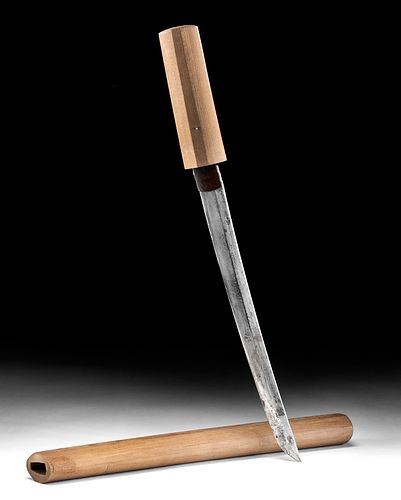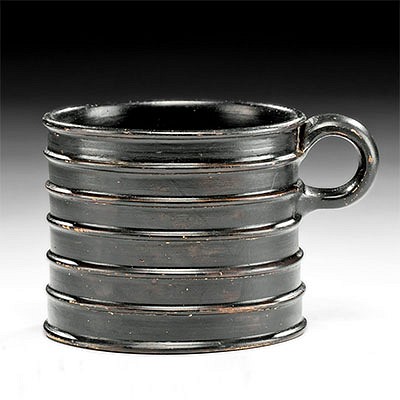Japanese Edo Steel Tanto w/ Wooden Handle & Sheath
Lot 90e
About Seller
Artemis Gallery
686 S Taylor Ave, Ste 106
Louisville, CO 80027
United States
Selling antiquities, ancient and ethnographic art online since 1993, Artemis Gallery specializes in Classical Antiquities (Egyptian, Greek, Roman, Near Eastern), Asian, Pre-Columbian, African / Tribal / Oceanographic art. Our extensive inventory includes pottery, stone, metal, wood, glass and textil...Read more
Categories
Estimate:
$550 - $800
Absentee vs Live bid
Two ways to bid:
- Leave a max absentee bid and the platform will bid on your behalf up to your maximum bid during the live auction.
- Bid live during the auction and your bids will be submitted real-time to the auctioneer.
Bid Increments
| Price | Bid Increment |
|---|---|
| $0 | $25 |
| $300 | $50 |
| $1,000 | $100 |
| $2,000 | $250 |
| $5,000 | $500 |
| $10,000 | $1,000 |
| $20,000 | $2,500 |
| $50,000 | $5,000 |
| $100,000 | $10,000 |
| $200,000 | $20,000 |
About Auction
By Artemis Gallery
Mar 12, 2020
Set Reminder
2020-03-12 10:00:00
2020-03-12 10:00:00
America/New_York
Bidsquare
Bidsquare : Ancient / Ethnographic Around The World
https://www.bidsquare.com/auctions/artemis-gallery/ancient-ethnographic-around-the-world-4957
Ancient art from Egypt, Greece, Italy and the Near East, as well as Asian, Fossils, Pre-Columbian, Native American, African / Tribal / Oceanic, Spanish Colonial, Russian Icons, Fine art, much more! Artemis Gallery info@artemisgallery.com
Ancient art from Egypt, Greece, Italy and the Near East, as well as Asian, Fossils, Pre-Columbian, Native American, African / Tribal / Oceanic, Spanish Colonial, Russian Icons, Fine art, much more! Artemis Gallery info@artemisgallery.com
- Lot Description
East Asia, Japan, Edo Period, ca. 1603 to 1868 CE. A forged-carbon-steel samurai's tanto, a short blade meant to accompany the katana and wakizashi. The shobu-zukuri blade design has a slightly lower edge line than the typical shinogi-zukuri style, a diamond-shaped (iori-mune) profile, and a lightly curved (chu-kissaki) tip that is not delineated by a vertical ridge. The length of the blade is presented with a gentle wave (notare-hamon) that is formed by the tight-grained hammer-folding process (itame-hada). The blade is housed within a modern wooden handle and storage scabbard (shirasaya) that is meant to protect the blade when not mounted in its normal buke-zukuri or tachi fittings. Size (w/ sheath): 1.5" W x 18.3" H (3.8 cm x 46.5 cm); (length of blade): 11.4" L (29 cm).
Tanto knives were typically worn by samurai along with the katana and wakizashi, though they were the weapons of choice amongst women of all societal classes. Typically worn alone, a tanto such as this example would be a quick and efficient means of protecting one's self in the event of danger or attack. This knife is most commonly associated with women and the practice of seppuku, ritual suicide by disembowelment, in order to avoid bringing shame or dishonor to themselves or their families.
Provenance: private J.H. collection, Beaverton, Oregon, USA, acquired in October 2015; ex-private Onomichi, Hiroshima, Japan collection
All items legal to buy/sell under U.S. Statute covering cultural patrimony Code 2600, CHAPTER 14, and are guaranteed to be as described or your money back.
A Certificate of Authenticity will accompany all winning bids.
We ship worldwide and handle all shipping in-house for your convenience.
#153897Blade is from the Edo period, and wooden handle and storage sheath are modern. Blade tang is adhered within handle and cannot be removed. Minor abrasions to blade, handle, and scabbard. Smooth patina throughout.Condition
- Shipping Info
-
All shipping is handled in-house for your convenience. Your invoice from Artemis Gallery will include shipping calculation instructions. If in doubt, please inquire BEFORE bidding for estimated shipping costs for individual items.
-
- Buyer's Premium



 EUR
EUR CAD
CAD AUD
AUD GBP
GBP MXN
MXN HKD
HKD CNY
CNY MYR
MYR SEK
SEK SGD
SGD CHF
CHF THB
THB













